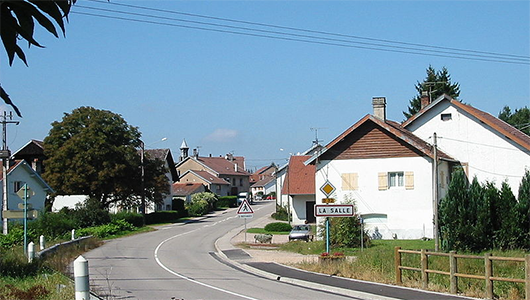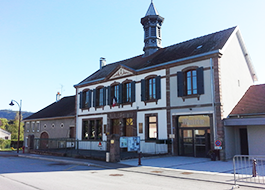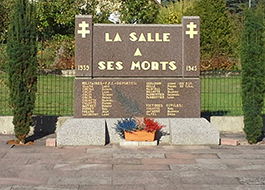La Salle
Durée visite : 30 minutes
Moyen : Pédestre
Pendant un millénaire, du VIe siècle avant notre ère au IVe siècle après J.-C, on a extrait la rhyolite dans les carrières des Fossottes. On en faisait des meules pour moudre le grain. La rhyolite est l’équivalent volcanique du granite. La présence romaine est attestée. Elle orienta l’évolution de la forme des meules. Mais les Romains ont ensuite abandonné de la rhyolite vosgienne au bénéfice du basalte.
Le hameau de l’Hôte du Bois, faisant partie du village de La Bourgonce, devient à la fin du XVe siècle le village de La Salle. C’est au cours de cette période qu’un maire syndic est élu dans chacun des deux villages, qui forment la paroisse Saint-Denis. Les charges afférentes à celle-ci se répartissant en 3/5 pour La Bourgonce et 2/5 pour La Salle. Le village n’a jamais eu d’église, il dépend au spirituel de La Bourgonce.
Il existait sur le territoire communal au XIXe siècle une ferme nommée La Caquellerie. Ce nom atteste la présence de coq de bruyère dans les bois voisins. Le caqué ou caquel désigne le chant emblématique du coq sauvage.
For a millennium, from the 6th century BC to the 4th century AD, rhyolite was mined in the quarries of Fossottes. They were made into millstones to grind grain. Rhyolite is the volcanic equivalent of granite. The Roman presence is attested. It guided the evolution of the shape of the grindstones. But the Romans then abandoned Vosges rhyolite in favor of basalt.
The hamlet of L’Hôte du Bois, part of the village of La Bourgonce, became at the end of the 15th century the village of La Salle. It was during this period that a syndic mayor was elected in each of the two villages, which form the parish of Saint-Denis. The charges relating to this break down into 3/5 for La Bourgonce and 2/5 for La Salle. The village has never had a church, it depends on the spirituality of La Bourgonce.
In the 19th century, there was a farm called La Caquellerie on the municipal territory. This name attests to the presence of heather cock in the neighboring woods. The caqué or caquel designates the emblematic song of the wild rooster.
Für ein Jahrtausend, vom 6. Jahrhundert v. Chr. Bis zum 4. Jahrhundert n. Chr., Wurde Rhyolith in den Steinbrüchen von Fossottes abgebaut. Sie wurden zu Mühlsteinen verarbeitet, um Getreide zu mahlen. Rhyolith ist das vulkanische Äquivalent von Granit. Die römische Präsenz wird bestätigt. Es leitete die Entwicklung der Form der Schleifsteine. Aber die Römer gaben dann die Rhyolith-Vogesen zugunsten des Basalts auf.
Der Weiler L’Hôte du Bois, Teil des Dorfes La Bourgonce, wurde Ende des 15. Jahrhunderts zum Dorf La Salle. In dieser Zeit wird in jedem der beiden Dörfer, die die Pfarrei Saint-Denis bilden, ein syndischer Bürgermeister gewählt. Die diesbezüglichen Gebühren sind für La Bourgonce in 3/5 und für La Salle in 2/5 unterteilt. Das Dorf hatte noch nie eine Kirche, es hängt von der Spiritualität von La Bourgonce ab.
Im 19. Jahrhundert gab es auf dem Gemeindegebiet einen Bauernhof namens La Caquellerie. Dieser Name zeugt von der Anwesenheit von Heidehahn im benachbarten Wald. Das Caqué oder Caquel bezeichnet das emblematische Lied des wilden Hahns.

Les habitants et les habitantes de La Salle s’appellent les Sallois et les Salloises.
The inhabitants of La Salle are called Sallois and Salloises.
Die Einwohner von La Salle heißen Sallois und Salloises.
Les points de visites
.
La Salle ne disposant pas d’église, la mairie supporte un clocher. Il permettait de lancer les alertes incendie, de rassembler la population pour avis importants. Ce fut le cas en août 1914, lors de la mobilisation générale.
On distingue de part et d’autre de l’entrée deux plaques commémoratives. Elles sont dédiées aux victimes civiles et militaires de la Garnde Guerre. Le village est cité pour son martyre de 1914.
La Salle does not have a church, the town hall supports a bell tower. It made it possible to launch fire alerts, to bring together the population for important opinions. This was the case in August 1914, during the general mobilization.
There are two commemorative plaques on either side of the entrance. They are dedicated to civilian and military victims of the Garnde Guerre. The village is cited for its martyrdom of 1914.
La Salle hat keine Kirche, das Rathaus trägt einen Glockenturm. Es ermöglichte die Auslösung von Feuermeldern, um die Bevölkerung für wichtige Meinungen zusammenzubringen. Dies war im August 1914 während der allgemeinen Mobilisierung der Fall.
Zu beiden Seiten des Eingangs befinden sich zwei Gedenktafeln. Sie sind zivilen und militärischen Opfern der Garnde Guerre gewidmet. Das Dorf wird für sein Martyrium von 1914 zitiert.
.
.
Ce monument sous forme de mur est en granit. Il est décoré de croix de Lorraine. Il honore les enfants de La Salle morts en 1939-1945. Les noms évoquent les victimes militaires, civils et les déportés.
Le sigle C.O.A. désigne les Commis et Ouvriers Militaires d’Administration. Le commis était le nom du spécialiste affecté aux tâches bureaucratiques. L’ouvrier était le nom de l’ensemble des personnels, servant dans la branche Exploitation de l’Intendance. Dès la déclaration de la guerre, le personnel se trouve renforcé par la mobilisation des sous-intendants militaires, et officiers d’administration du cadre auxiliaire. Les officiers de réserve occupent pour la plupart dans la vie civile des fonctions administratives, soit des professions se rattachant a l’alimentation, à l’industrie du vêtement, de la chaussure, de l’équipement. Un régiment d’infanterie de forteresse ou R.I.F. est une unité militaire française spécialisée dans la défense des fortifications de la ligne Maginot.
Sur la droite se trouve un hommage au jeune André, mort le 4 septembre 1914, à l’âge de 14 ans, en combattant l’envahisseur.
This monument in the form of a wall is made of granite. It is decorated with the cross of Lorraine. It honors the children of La Salle who died in 1939-1945. The names evoke military, civilian and deported victims.
The acronym C.O.A. means the Clerks and Military Workers of Administration. The clerk was the name of the specialist assigned to bureaucratic tasks. The worker was the name of all the staff serving in the Operations branch of the Stewardship. As soon as war was declared, the personnel was reinforced by the mobilization of military sub-intendants and administrative officers of the auxiliary framework. Most of the reserve officers in civilian life occupy administrative functions, that is, professions relating to food, the clothing industry, footwear, equipment. A fortress infantry regiment or R.I.F. is a French military unit specializing in the defense of the fortifications of the Maginot Line.
On the right is a tribute to the young André, who died on September 4, 1914, at the age of 14, fighting the invader.
Dieses Denkmal in Form einer Mauer besteht aus Granit. Es ist mit dem Lothringerkreuz geschmückt. Es ehrt die Kinder von La Salle, die zwischen 1939 und 1945 starben. Die Namen erinnern an militärische, zivile und deportierte Opfer.
Das Akronym C.O.A. bezeichnet die Angestellten und Militärarbeiter der Verwaltung. Der Angestellte war der Name des Spezialisten, der für bürokratische Aufgaben zuständig war. Der Arbeiter war der Name des gesamten Personals, das in der Operationsabteilung der Verwaltung tätig war. Sobald der Krieg erklärt wurde, wurde das Personal durch die Mobilisierung von militärischen Subintendanten und Verwaltungsbeamten des Hilfsrahmens verstärkt. Die meisten Reserveoffiziere im zivilen Leben üben Verwaltungsfunktionen aus, dh Berufe in Bezug auf Lebensmittel, Bekleidungsindustrie, Schuhe und Ausrüstung. Ein Festungsinfanterie-Regiment oder R.I.F. ist eine französische Militäreinheit, die sich auf die Verteidigung der Befestigungen der Maginot-Linie spezialisiert hat.
Rechts eine Hommage an den jungen André, der am 4. September 1914 im Alter von 14 Jahren im Kampf gegen den Eindringling starb.
.
Cette ancienne ferme présente les caractéristiques de l’habitat des Vosges gréseuses, haut bassin de la Meurthe. Plus larges que profondes, les maisons ont trois ou quatre travées ou rains. Les fermes présentent le plan traditionnel du bâtiment rectangulaire couvert d’un toit à deux pans, structuré en travées fonctionnelles. Ici de gauche à droite, on trouve habitation, grange, étable et remise. Les fermes standards étant conçues pour trois à sept bovins. Leurs pignons sont percés de quelques fenêtres et même, à l’étage d’une grande ouverture, la bauchée. Celle-ci permettait de rentrer le fourrage au grenier. Les granges et remises sont reconverties en garages. La belle couleur de grés qui encadre portes et fenêtres, l’éclat des enduits de chaux, donnent à ces maisons un bel air de gaité.
This old farm has the characteristics of the sandstone Vosges, the upper basin of the Meurthe. Wider than deep, the houses have three or four bays or channels. The trusses have the traditional plan of a rectangular building covered with a gable roof, structured into functional spans. Here from left to right, there is a house, barn, stable and shed. Standard farms are designed for three to seven cattle. Their gables are pierced with a few windows and even, upstairs with a large opening, the bauchée. This allowed the fodder to be brought into the attic. The barns and sheds are converted into garages. The beautiful sandstone color that frames the doors and windows, the brilliance of the lime plaster, gives these houses a beautiful air of gaiety.
Dieser alte Bauernhof hat die Eigenschaften der Sandstein-Vogesen, des oberen Beckens der Meurthe. Die Häuser sind breiter als tief und haben drei oder vier Felder oder Kanäle. Die Traversen haben den traditionellen Grundriss eines rechteckigen Gebäudes, das mit einem Satteldach bedeckt ist und in Funktionsbereiche unterteilt ist. Hier von links nach rechts gibt es ein Haus, eine Scheune, einen Stall und einen Schuppen. Standardfarmen sind für drei bis sieben Rinder ausgelegt. Ihre Giebel sind mit ein paar Fenstern durchbohrt und sogar oben mit einer großen Öffnung das Bauchée. Dadurch konnte das Futter auf den Dachboden gebracht werden. Die Scheunen und Schuppen werden zu Garagen umgebaut. Die schöne Sandsteinfarbe, die die Türen und Fenster umrahmt, der Glanz des Kalkputzes verleiht diesen Häusern eine schöne Fröhlichkeit.








